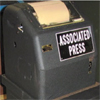It was exciting to read Twitter when it first began sharing breaking news in 2006.
In the early part of the 20th century, newsrooms must have felt the same excitement as the first (and often loud) Teletype machines began printing out news updates.
Although the technology had been around for a number of years, and the Associated Press started experimenting with teleprinter machines in 1914, commercial Teletype service didn’t start until November 20, 1931.
The clattering sounds of Teletype news would fill newsrooms for years to come.
This video shows an old United Press Teletype machine in use.
Just imagine all the important news stories AP machines printed out from 1914 through the 1980s.
“Thanks to Teletypes, America read 20th-century history the day it was made. Da dacka-dacka. Lindy makes it! Dacka-dacka. The Hindenburg explodes! Dak-dak-dak. Japanese bomb Pearl Harbor! Germany surrenders! Atomic bomb destroys Hiroshima! Kennedy shot!
Clattering keys, ringing bells and scrolling paper churned from those squat, black boxes with the glass lid. But soon all that sound and fury will grow still. United Press International recently replaced the last of its old Teletypes with modern, high-speed printers, and the Associated Press has announced that by mid-September it expects to do the same. An era in journalism – and Americana – is coming to an end.
….A flash was the highest order of urgency on the news wires: a short item to alert editors of news ‘of transcendent importance,’ according to AP, to be followed by a bulletin, usable for publication. Flashes were signaled by 12 bells on AP machines and 10 bells on UPI’s, and they could stop the whole nation in its tracks.”
— “Saying Goodbye To The Teletype”
Philadelphia Inquirer, 1986
The movie “All the President’s Men” ends with breaking news from one of the great journalism tools of all time, the Teletype machine.






